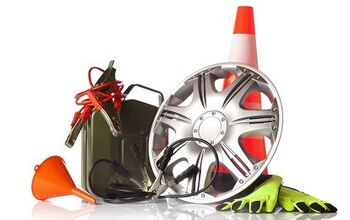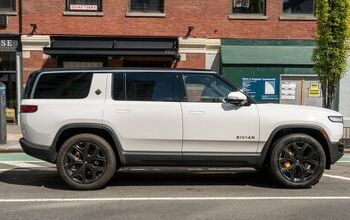Winter Tires: What You Need to Know to Stay Safe in the Snow
We take a closer look at winter tires and how they can help you drive safer
Winter tires have come a long way over the last couple of decades, from being more like mud tires to becoming something highly specialized and exceptionally good at gripping in ice, snow, slush, and cold. At the same time, the best winter tires are even better than before at giving you improved fuel economy, less noise, and even high-performance dry weather handling. If you pick the right ones, that is. This is your guide to winter tires, telling you what you need to know to help keep you out of the snowbanks this year.
These tires aren’t called snow tires anymore, and there’s a good reason. Winter tires can do so much more, and it’s thanks to better engineering in the materials that go into the tire, the rubber compound, and even the tread pattern. To help guarantee you’re getting a properly capable winter tire, the tire industry introduced the three-peak mountain snowflake. That symbol, which launched in 1999, is a mark approved by U.S. and Canadian tire associations that sets a performance standard for winter tires. The mountain snowflake symbol is one of the best ways to ensure you’re getting a real winter tire, making the old M+S badge obsolete.
Save $100 on Select Winter Tires with eBay Motors
The snow is going to start falling before you know it, so the time is now to get yourself a set of quality winter tires to keep your vehicle glued to the road.
And if you buy your winter tires from eBay.com, you can save $100. This deal lasts until 11:59 PM Pacific Time on November 1, 2021. A $400 minimum purchase is required to take advantage of this discount. The discount applies to the purchase price (excluding shipping, handling, and taxes) of eligible items from DiscountTireDirect and SimpleTire.
So don’t wait…this sale doesn’t last long. Click the banner below to take full advantage, or just click here.
Lead photo By m.mphoto/Shutterstock.com
Table of contents
- What do Winter Tires Do?
- How do Winter Tires Work?
- When Should I Install Winter Tires?
- How to Avoid The Rush
- Change My Own Tires?
- When do I Remove Winter Tires?
- Under Pressure
- What do I do with Winter Tires?
- When do I Need to Replace Winter Tires?
- Winter Tire - Michelin X-Ice Snow
- Winter Tire - Bridgestone Blizzak
- All-Weather Tire - Nokian WR G4
What do Winter Tires Do?
Winter tires have two main tasks: giving you traction on ice and snow and keeping their grip when the thermometer drops below 40 degrees.
Summer tires, and even all-season tires, are designed to perform well down to around 40 degrees. Their rubber compounds stay flexible and pliable to around that temperature. When it gets colder, they rapidly lose grip even on dry pavement.
How do Winter Tires Work?
Winter tires are designed to stay pliable at temperatures down to -40 and colder. That means that their rubber will grip the pavement even when it's too cold to step outside. For traction on snow and ice, the tires offer a complex series of tiny grooves. These grooves are called sipes, and they give you most of your slippery road traction.
The tiny cuts open slightly when they come in contact with the pavement, meaning there is more rubber to grip the asphalt. On snow and ice, the cuts mean that there are more edges to bite into the slippery surfaces, and that is what gives you better traction on those surfaces. The right combination of sipes and winter tire rubber compounds offer almost as much traction on ice as studded tires, while offering much better grip on dry, wet, and snowy surfaces.
When Should I Install Winter Tires?
When your winter tires should go on depends on where in the country you live. The guideline from tire makers is when the low temperatures start to drop under 40 degrees. That could mean September or it could mean early December, depending on where you live. Don't rely on the daily forecast, though, look at the history for your area. Regions that need winter tires usually see a big backup at tire stores and garages around changeover time, and if you wait too long you could be stuck on summer tires and waiting in line when everyone tries to make the changeover.
How to Avoid The Rush
If you want to save some money and forget about the winter rush, having your winter tires mounted and installed on a second set of wheels is a great way to do it. A set of winter wheels dedicated to winter tires means you can change for winter by yourself at home.
Steel is a popular choice for winter tires. It’s plain, basic, and strong, so the damage and corrosion caused by salt, slush, and snow, isn't a worry. The solid steel wheels are often stronger than aluminum wheels as well (and easier to repair), giving you extra protection during pothole season. If you don't like the basic black look, a quality set of wheel covers makes your ride look almost as good as the factory wheels.
Change My Own Tires?
Sure, changing your own wheels is a handy skill to have. You'll need a few tools in your garage to help you out. A floor jack is the quicker and safer way to lift your vehicle off the ground so you can remove the tire. Use a jack stand as well for safety, and never get under a vehicle held up only by a jack.
A long-handled wrench called a breaker bar is the best way to loosen the lug nuts on your vehicle. They're fastened tightly, so the extra force of the longer handle gives you extra leverage. Loosen (but don't remove) the lug nuts before you lift your vehicle, otherwise, the wheel will turn and loosening is much tougher.
A torque wrench is used after you've put your new wheels and tires on the vehicle. Proper bolt torque, written in your owner's manual, is extremely important for safety, and to make sure your wheels don't come loose or fall off. Always re-torque your wheels after 60 miles whenever they've been taken off and put on the vehicle.
Even if changing tires isn't up your alley, a dedicated set of winter wheels can speed up your trip to the shop and make it easier to get to the front of the line.
When do I Remove Winter Tires?
Once you're confident that temperatures will stay above 40, it's safe to swap back to summer or "all-season" tires. While leaving your winter tires on all year, or at least until the lines at the tire stores disappear, can be tempting, we recommend against it. Running winter tires at warmer temperatures can mean rapid tire wear, poor handling and longer stopping distances, and other forms of abnormal tire wear that can cause tire and even suspension damage.
If your area sees a few days of snow and cold, but most of the winter isn't below 40, there is another option. Called all-weather tires, these wear the mountain snowflake logo, but are also safe to use in warmer weather. They use modern technology along with modern rubber compounds to create a tire that will work better than all-season tires in cold temperatures - if not as well as full winters - and that can also handle summer temperatures safely. They still offer compromises versus full winter or summer tires, but are a great balance for areas with mild winters.
Under Pressure
As the seasons change and the temperatures drop, the pressures in your tires can fluctuate much more than in the summer. So it's a good idea to check your pressures more frequently over the cold season using a high-quality tire gauge to make sure your tires work optimally.
What do I do with Winter Tires?
When your winter tires aren't on your car or truck, you'll need to store them somewhere. The same goes for your summer tires when they are off of the vehicle. We've got some great ways to keep them safe and securely stored at home.
Tire bags protect your tires and wheels from damage and UV rays, helping to extend their life in storage. They keep your hands clean, and most tire bags have a convenient handle that makes easy work of carrying your tires from basement or garage to trunk and back.
A tire storage rack is a great way to stack and store your tires for the off season. Some models stay in place on the floor, holding your tires. Others have wheels and can let you roll your wheels and tires out of the way for convenience.
If your floor space is at a premium, wall-mounted storage is another great way to store your winter tires. Wall-mount racks can fold up when you're not using them and fold down when you're ready to store your tires up high and out of the way in your basement or garage.
When do I Need to Replace Winter Tires?
All season and summer tires usually offer ok, if not great, performance in dry and damp conditions all the way down to 2/32nds of tread remaining. That's the depth where you'll see the small lines at various places around the tire become flush with the tread. Once they get to that small amount of tread remaining, it's time to replace them. Both for safety and because in many places it's the law.
Winter tires, though, need more tread to properly grip snow, slush, and ice. Even the best recommend replacement at 4/32nds, and many will lose noticeable traction in the snow at 6/32nds. So no, they don't last quite as long as summer tires, but tire companies still haven't found a way around it.
So how do you know when your winter tires need changing? Use a treadwear depth gauge. These small instruments line up with the body of the tire and the highest point on the tread and give you an easy to read look at how much tire is left. Measure at the inside, center, and outside of the tread, taking at least two sets of measurements at different places around the tire.
Winter Tire - Michelin X-Ice Snow
There are dozens of winter tires that wear the mountain snowflake icon, but some are better than others. Let’s look at some of our favorites.
Michelin is one of the top tire companies in the world, making excellent winter tires. The X-Ice Snow upgrades the classic X-Ice with even better snow traction. Two different types of 3D sipes run the full depth of the tread, helping to extend life and add traction. The new V-pattern helps evacuate more water and slush. And Michelin claims it will last up to one extra season than the competition.
Winter Tire - Bridgestone Blizzak
Bridgestone's Blizzak series of tires includes options for cars, crossovers, SUVs, and trucks. Blizzak tires have microscopic bite particles that grip snow and even glare ice and more fresh particles are exposed as the tire wears. 15 percent more block edges adds more rubber to grip in bad weather, with new grooves running both around and across the tire to help evacuate snow, slush, and rain. Some of the latest Blizzak tires offer a built-in tread indicator that appears when the tires are reaching the end of their best traction.
All-Weather Tire - Nokian WR G4
Nokian is a Finnish company that is less well-known here, but makes excellent cold weather tires. They make an excellent all-weather tire too. The WR G4 is designed to offer predictable grip in all temperatures and on snowy and wet roads. Its tread is designed to stay pliable in the cold but the pattern helps make sure it has summer tire-like stability in warm weather. It also offers fuel economy and noise levels closer to a conventional all-season tire.
We are committed to finding, researching, and recommending the best products. We earn commissions from purchases you make using the retail links in our product reviews. Learn more about how this works.
Evan moved from engineering to automotive journalism 10 years ago (it turns out cars are more interesting than fibreglass pipes), but has been following the auto industry for his entire life. Evan is an award-winning automotive writer and photographer and is the current President of the Automobile Journalists Association of Canada. You'll find him behind his keyboard, behind the wheel, or complaining that tiny sports cars are too small for his XXXL frame.
More by Evan Williams









































Comments
Join the conversation